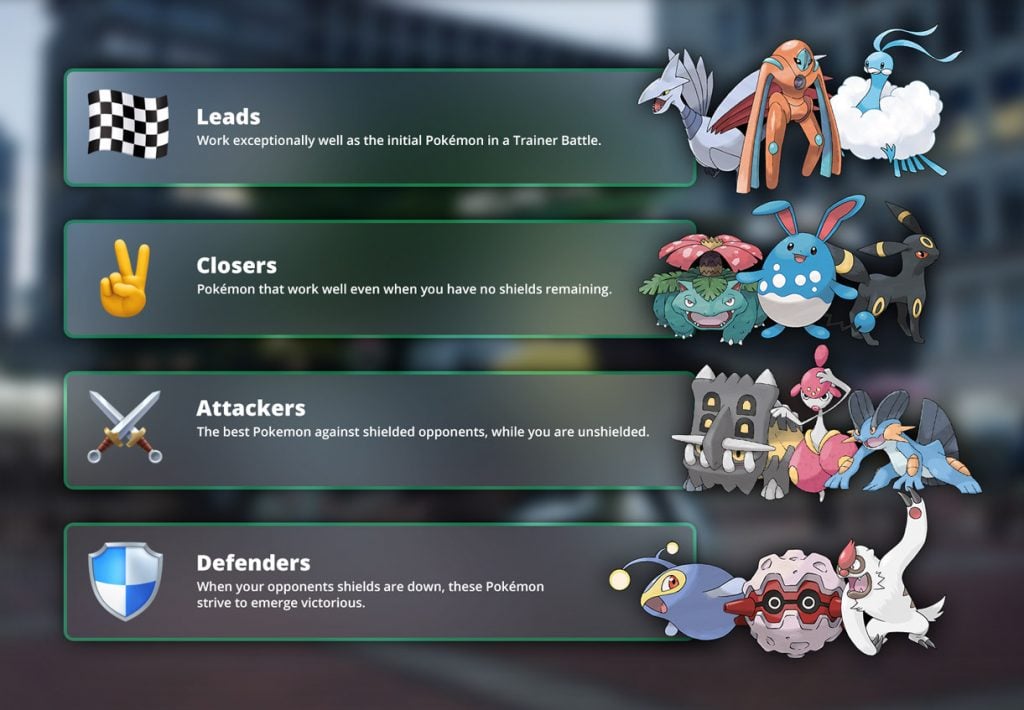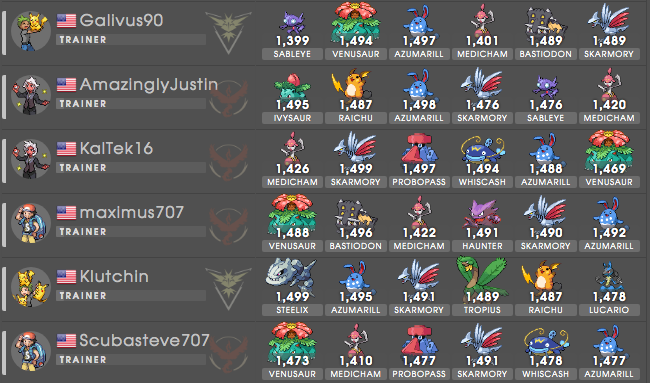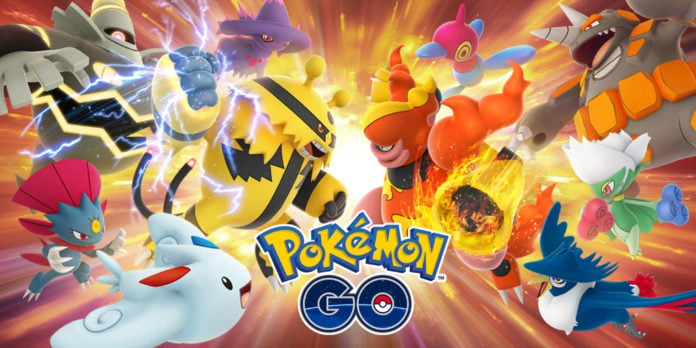Ever since the inception of Trainer Battles as a core feature in Pokémon GO, the Great League has been the most competitive and quintessential league for trainers to verse each other in. The low barrier to entry, coupled with the unique chance to use less popular Pokémon that don’t cut it in the world of Raids and Gym Battles, makes Great League PvP the cornerstone of Trainer Battles. Trainer Battles is the ideal place for new and seasoned trainers to start battling casually or competitively in.
This guide will help trainers to build a basic, but comprehensive, Great League team that will perform well in the Open Great League meta, where there are no special rules and restrictions apart from the 1500 CP cap. Specialized themed metas, such as the monthly Silph Arena cups, can heavily fluctuate the viability of any Great League eligible Pokémon. However, the same basic principle to team building listed in this guide can also be applied to the process of team building for any given Silph Arena cup. Cost-effective alternatives to some of the exemplary Great League Pokemon are also listed in this guide.
Finding the right balance
Every comprehensive Great league team must have balance and synergy among its members. Just like with any good sports team that requires a balance of attack-minded, defense-minded as well as all-round players, so too does a competitive PvP team.
This balance can be struck when there is sufficient coverage of Leads, Attackers, Defenders, and Closers. In case you are unfamiliar with this nomenclature, here is a quick refresher on what they mean:

Lead: A lead Pokémon, as the name suggests is the Pokémon you send out into battle first. Leads tend to have decent bulk, as well as a substantive amount of offensive pressure; either by firing off charged moves rapidly or by chunking away at the opponent with certain heavy-hitting fast moves.
Some Pokémon that perform triumphantly in this role are:
 Deoxys (Defense)
Deoxys (Defense)
 Altaria
Altaria
 Mantine
Mantine
For intermediate and seasoned trainers who want to compete in tournaments and have the resources and inclination to do so, Deoxys Defense Forme is a formidable Lead Pokémon in PvP. Being a mythical Pokémon, it is somewhat exclusive to obtain and costs a small fortune to unlock the second charge move. However, it is a worthy investment and will continue to be a force to be reckoned in the years to come.
If you are someone who is on the fence about getting into PvP, and are unsure about how much stardust you wish to spend, Altaria should be one of the first, if not the first PvP Pokémon to invest in. Ranked as the overall Number 1 Great League Pokémon by pvpoke.com Altaria requires 400 Candy to evolve, however, Swablu are abundantly available in the wild and only require 10,000 Stardust to unlock the second charge move.
Closer: Closers are at their pinnacle when there are no shields (on your side and your opponent’s) at play, and are typically sent out at the tail-end of the battle to clean up and finish the job. They tend to have good typing, decent bulk, and a combination of good charged moves to perform their role appropriately.
Pokémon that excel in this role are:
 Azumarill
Azumarill
 Skarmory
Skarmory
 Umbreon
Umbreon
Followed closely behind Altaria, are Azumarill and Skarmory, two other veterans of the Great League and are ranked Number 3 and 5 respectively by PvPoke. They are both a little expensive to optimize for the Great League:
- Skarmory being somewhat rare and requiring 75,000 stardust to unlock a 2nd charged move,
- and Azumarill requiring to be basically maxed out all the way to be viable.
There is a cost-effective workaround for newer trainers who wish to invest in at least of the above Pokémon. Azurill, Azumarill’s baby pre-evolution, can be hatched quite easily from 7km eggs. We recommend trading with a Lucky Friend to get a Lucky Azurill. And with Baby Pokémon only requiring 10,000 Stardust to unlock a 2nd charged move, a lucky Azurill with 2 moves is the most cost-effective and smart way to reach up to a fully optimized Azumarill.
Attacker: An attacker’s role is primarily to go up against shielded opponents while you yourself are unshielded. More often than not, Attackers are naturally bulky and have key sets of resistances, and are thus able to apply shield pressure against their opponents.
The best Attackers in the Great League currently are:
 Bastiodon
Bastiodon
 Medicham
Medicham
 Whiscash
Whiscash
Almost no Great League team can be complete without colossi like Bastiodon and Medicham. However, with great power, comes great…stardust costs. Both require maxing out almost all the way to be viable in the Great League, as well as having expensive costs associated with unlocking the 2nd charge move.
The cost-effective alternative to Bastiodon is Probopass. Common in certain biomes, but also easily available from Magnetic Lures, Probopass has all the makings of a cheaper Bastiodon. However, cheaper only in cost, and not in function and utility. There are many who argue that Probopass is overall better than Bastiodon.
Defender: Defenders flourish when a Trainer commits to shielding them twice, generally against unshielded opponents. They are able to absorb the pressure and dish out heavy damage in return. Some of the most commonly used Defenders in the Great League are:
 Zweilous
Zweilous
 Swampert
Swampert
 Froslass
Froslass
If you have a Great league optimized Zweilous in your arsenal, the evolved form of Deino, you are a very lucky trainer as Deino are currently one of the rarest Pokémon to find or hatch in the game. Not to mention the 75,000 stardust cost associated with unlocking its second charge moves, makes Zweilous an elite Pokémon to obtain and power up.
Compared to Zweilous, both Swampert (with Hydro Cannon) and Froslass are much cheaper to obtain and power up for the Great League. Most Pokémon with energy-efficient and hard-hitting charged moves, such as the Community Day exclusive charged moves perform exceptionally well as Defenders. Other notable, but budget-friendly Pokémon that make the cut as a good Defender include all the Starter Pokémon of each generation with their Community Day charged moves.

Optimal PvP IVs
The last major topic to brush upon in this guide is the concept of Optimal PvP IVs. IVs or Individual Values, are hidden stats applied to each Pokémon that are instrumental in determining the true power and potential of a Pokémon. In many ways, they are like the genes of Pokémon. Each individual battle stat (Attack, Defense, and HP or Stamina) has an Individual Value associated with it and in Pokémon GO, vary from 0 to 15.
If you are a new trainer, or someone who is looking to get into PvP seriously and compete at a high level, it is becoming increasingly important to pay attention to a Pokémons IVs. In short, IVs matter. Unlike for Pokémon that are used in Raids and Gym battles, where a 100% IV Pokemon (15 Attack, 15 Defense, and 15 Stamina) is the way to go, Great League PvP demands a different combination of IVs for a Pokémon to reach its maximum potential.
For Pokémon that max out at or just under 1500 CP, a 100% IV of its kind is still the way to go. However, for Pokémon that have much larger maximum CPs, a combination of low attack combined with a high defense and high HP is the optimal way to go. For precise PvP IV rankings, GO Stadium has created this PvP IV Rankings and Calculation Tool.
Conclusion
To conclude, building a basic but balanced Great League Team isn’t just about picking the “strongest” Pokémon. Team synergy, optimal movesets, IVs, as well as other special nuances like understanding a particular meta, predicting your opponent’s lead, shield baiting, and energy farming to name a few, are all very important. Future guides will touch upon these nuances in greater detail, but for now, this guide will serve as a starting point and a window into the world of Great League PvP.

